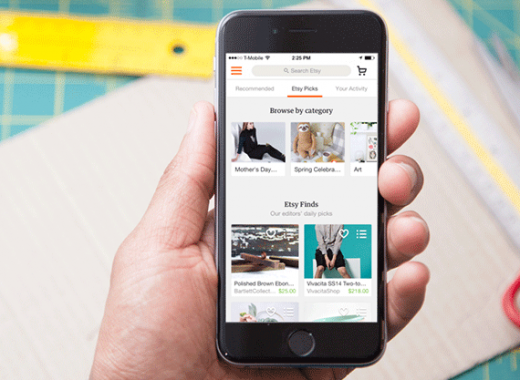Selling on Etsy: How to Get Started in Just 10 Days
You’ve found your product. You’ve identified your market niche. Now it’s time to set up your shop and start selling on Etsy.
Etsy is the home for original, handcrafted, or vintage products sold by regular people. Selling on Etsy is a great idea; Etsy is the sixth-largest online marketplace in the world, with over 46 million users. Putting your product on Etsy thrusts it into the limelight, practically guaranteeing eyes on your listing from across the globe.
Now is a great time to begin selling on Etsy because people are excited to support small businesses. There has been a lot of media focus on the effect of the pandemic on small businesses, and the community’s support could be a great launching point for a new Etsy shop.
Whether you’re looking for a part-time gig or intend to make Etsy your full-time job, we can help guide you through the process of setting up your Etsy store and selling your first product in just 10 days.
Day 1: Create Your Brand
Before you log on to Etsy, take a day to create your brand — the name of your shop, your logo, and your brand’s personality.
Choose a Unique and Evocative Name
Choosing your store name can be tricky, but it’s one of the most important aspects of the setup process. Your store name should evoke a feeling that you want associated with your store and products. Keep in mind what the primary draw of your Etsy store is when choosing a moniker. If it’s unique because it’s handcrafted, organic, or vintage, try to include that in your brand name.
Before deciding on a name, be sure you search Etsy/Google for similar names, and make sure it’s not taken or potentially confusing to customers who might run into a different shop with a similar name. At the same time, you don’t want your name to be so generic that it won’t ever turn up during a search.
In addition to evoking a feeling and providing some information about your product, the name of your store should be unique and memorable but also legible and sensible so it’s easy to find.
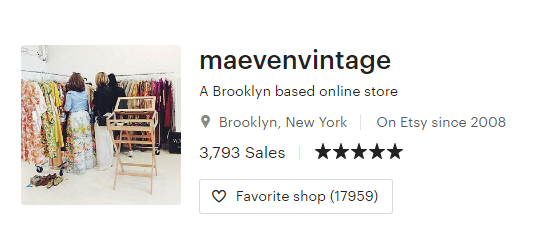
Maeven Vintage is a great example of a shop name that works. “Vintage” is useful — it describes the products being sold. And “Maeven” is a unique form of “Maven,” which literally means “expert or connoisseur” and adds a dash of elegance and panache.
Invest in Logo Design
Similarly, your logo should be simple and clear, but also captivating and memorable. This is when it’s best to contact a designer on Fiverr or another gig website who can help come up with a professionally designed logo.
The logo is the first image associated with your brand and is an important first impression. It is your first communication to the customer about your brand.
We’ll call out Maeven again, because, hey, we’re here. That is a clean, simple logo that oozes “vintage art deco,” with a feeling of sharpness and speed that evokes modern design. The way the words seem to be fading also suggests a memory, but the crisp lines suggest that the memory has been well preserved.
Create a Communication Strategy
You’ll want to decide in advance what your brand’s “voice” is. Don’t get too deep into the weeds here, but make a plan for how you plan to communicate with customers, and keep it consistent.
When you communicate directly with customers, you will, of course, want to be professional, but Etsy thrives on the personal touch, so keeping some of your personality in communications with customers is important.
The first way to do that is through your messages or emails with customers: answer their questions in a timely manner. Take the time to thank them for their question or purchase, and ask if they’re satisfied with the product. Many Etsy sellers also include a thank-you card or small thank-you “gift,” such as a sample product — one that a customer might later buy in full-size — when they send their products.
Day 2: Make Your Etsy Account
On day two, once your brand is in order, it’s time to make your Etsy account and start setting up your Etsy store.
Set Up Your Account
We recommend using a desktop or laptop to initially create your Etsy store. After the store is made, it can be managed via Etsy’s app later on.
To set up a shop, you will need an Etsy account. If you’ve purchased from Etsy in the past, you can use that same account and just click “Sell with Etsy” near the top middle-right of any page.

If you do not yet have an Etsy account, you will need to create one. Simply go to Etsy.com, click “Sign In” at the top-right corner of the screen, and click “Register” in the new pop-up. From there, follow the prompts to enter your email and new password, then confirm your account.
Fill Out Your Etsy Profile
Once your Etsy account/store is created, you can start incorporating personality by creating an opening announcement and filling out some info in your profile.
Your opening announcement should include your shop banner and logo. This will make a clear statement to customers and fellow retailers about what your shop/brand is about.
Your profile allows you to add a lot of personality: you should include a nice photo of yourself, along with an engaging story. How did your business get started? What inspired you to create/find these unique products? You may also include a video to reach customers, explaining how your product is made. People love passion — share yours.
This is a great time to include information on the unique process of product creation or to outline details such as ingredients being organic or practices focusing on sustainability. The information you include in your profile when you create your Etsy account will help customers and the Etsy community learn more about you and your business.
Day 3: Study the Etsy Policies Relevant to Your Store
Opening a store of any kind, online or otherwise, comes with its own set of rules and regulations. Familiarize yourself with Etsy’s policies to better understand how your shop works, how you get paid, and how your store is protected.
Etsy Charges Per Listing
Etsy sets a fee of $ .20 per listing when the listing is created, regardless of whether the product sells.
But that’s not the end of it: listings for most products expire after four months. Etsy does provide an auto-renew feature that enables sellers to easily keep their listings active longer than four months.
Once the four-months is up, you will automatically be charged the $ .20 to renew your listing. This is a helpful way to keep track of inventory without having to recreate listings.
You do not have to pay a listing fee if you are editing a preexisting listing. There are slightly different rules for creating a private listing for certain types of products, but this limits your customer exposure on Etsy.
The Etsy fee structure is fairly labyrinthine: for a more comprehensive education, consult our complete guide to Etsy fees to learn more about how, why, and when Etsy’s fees are charged.
Reviews Can Make or Break Your Shop
Reviews are very important on Etsy. They determine not only whether or not a customer will choose your shop over similar shops but also how many eyes Etsy will put on your shop.
Etsy employs a five-star rating system that customers can use once their product is marked as “delivered.”
Now, here’s the rub: reviews expire after 100 calendar days. This is done by Etsy to provide up-to-date quality information for new customers, but it also means you can’t rest on your laurels. Consider adding “please review your experience” or a similar message at the end of all of your customer communication and confirmation emails.
Ensuring that customer service and shipping are hassle-free will help manage the kind of bad reviews that are focused on the process rather than on the product itself. It is helpful to include up-to-date shipping information in your listings and purchases so that people who feel their item arrived late don’t leave a negative review.
You can see their reviews by going into the “Shop Manager,” clicking the name of the shop in “Sales Channels,” and then clicking on “Reviews.” You can also find your rating there. A high rating not only adds to your shop’s authority but also determines whether or not you have access to Etsy’s Seller Protection Policy.
Etsy’s Seller Protection Policy Helps Resolve Disputes
Etsy does have a seller protection policy, which most shops will qualify for and which requires no outside application policy. In order to qualify for the seller protection policy, your shop must be in good standing and use basic features, such as Etsypay.
The protection policy allows for the seller to receive help from Etsy corporate if there is a case that needs to be resolved. This generally means helping to mediate disputes between buyers and sellers over product quality concerns, shipping issues, chargebacks, and other payment disagreements.
Day 4: Visit the Etsy Forums
Creating and managing an online store can be a lonely business — take advantage of the Etsy community to learn from the pros and maybe create a network of helpful contacts.
Forums are a great way to get questions answered, especially for an Etsy newbie. Forums can include almost anything, from latest trends with your products to expert tips from sellers. The Etsy forum community is diverse and knowledgeable; exploring forums when you create your shop will undoubtedly lead you to some useful information.
Be sure to contact other sellers for cross-promotion. The sellers you choose to cross-promote should provide something similar to your product, but one that you do not provide yourself.
For instance, if your Etsy shop includes antiques from the Depression period, but a customer is looking for something mid-century modern, it would be great to link a fellow antique dealer who specializes in mid-mod. They can cross-promote your shop as well, which will lead to a wider buyer base for both of you. You can use Etsy Teams to meet similar sellers.
Day 5: Take a Crash Course in SEO to Perfect Your Copy
You next step is to spend a day learning about SEO — search engine optimization. The text on your website — also called copy — is crawled by Google, which then uses that information to guide users toward or away from your site. Making your copy as search-engine-friendly as possible is paramount.
You don’t have time to become an SEO expert in a day, but a few quick lessons can help Google (and future customers) find your Etsy store.
Find Your Keywords
One of the most basic principals of SEO is to find a useful, descriptive keyword that people are proved to be searching for.
If you’re selling furniture, keywords to look for might be “couch,” “reclining chair,” or “end table.” For custom jewelry, it might be “crystals,” “homemade jewelry,” or (surprise) “custom jewelry.”
There are free tools that can help you do a little keyword research beforehand. Wordtracker, Google Trends, and Keyword Generator can tell you whether people are searching for your terms, and even how hard it might be to grab Google’s attention with your own products.
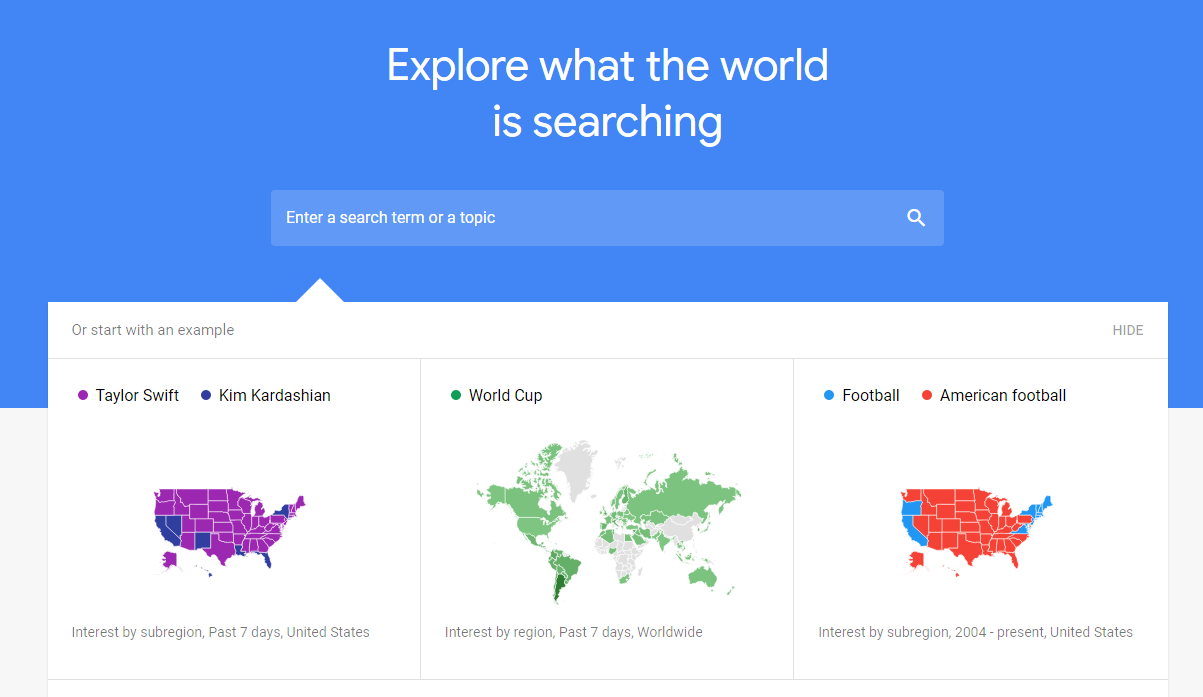
Plug some keywords about your product into these research tools and see what they turn up. Then, you can adjust your writing accordingly, adding those keywords into all of your product descriptions and marketing material.
Don’t Be Afraid to Brag About Your Expertise
Another principle of SEO is called “EAT,” or “Expertise, Authority, and Trustworthiness.” In your product copy, your store description, and your marketing, you need to at least touch on all three pillars. It wouldn’t be unwise to start a blog as well, with personal or product-related topics that sneakily improve your shop and brand’s SEO.
You should showcase your expertise — why are you selling or making this product and why should we care? Authority is a little tougher when you’re starting out; this is basically a measurement of your clout, your established credentials, or how beloved your brand or product is. You’ll be working on that. Third is Trustworthiness; this is where reviews and testimonials come in.
Some high-quality pictures can at least showcase how expertly made or sourced your product is, which can help with all three pillars.
Day 6: Take High-Quality Product Photos
A product photo provides shoppers with a first impression, so make it a good one. Most visitors to your shop will look at the product image before they read anything but the name. We have a few basic tips to help you get the most out of basic lighting and even just a camera phone for photography.
Invest in Lighting
It is helpful for pictures to look consistent (same lighting/background) and even include matching labels to look professional.
Early-morning light or even outdoor light helps showcase products, but you can also purchase a ring light so that you can create listings indoors at any time.
Listing photos should be well- lit and clear. Avoid shadows or blurriness. If you’re using a camera phone, be sure to adjust your settings to avoid things like flash or panoramic views. Flash will generally wash a product out, flattening all details and making it look two-dimensional. In fact, when lighting any product, try to light it from multiple angles to soften hard shadows, to help the product stand out from the background, and to make it appear more three-dimensional.
In addition, you can purchase lighting and backdrop equipment for a reasonable price if you prefer a clean white background and professional-looking lighting.

Up Your Photography Game
Your phone’s camera will work fine if you have decent lighting and a little patience, but you can improve your photography dramatically with a few reasonably priced accessories. There are several lenses you can purchase for a camera phone, depending on the look you want for your product listing. Moment, Olloclip, and Nelomo make excellent and affordable lenses that snap right onto your current phone.
If you want to provide clarity on the size of your product, you can include a photo “to scale” with something the consumer can reference, like a quarter. So if you’re selling lip balm in one-ounce tins, including a quarter next to the tin in the listing picture will help the customer get a good idea of how much product your listing includes.
If you don’t want to become an expert on product photography, you can also hire an expert to touch up your basic photos for minimal costs. They can be found pretty easily on sites like Fiverr, Upwork, and Freelancer. This will ensure a professional look without as much work on your part.
Day 7: Create Your Listings
On the seventh day, you won’t be resting. Instead, you’ll be doing one of the most important steps — creating the listings for selling on Etsy.
To create a listing, you must have a photo, choose a price, describe your product, and determine shipping details. Sign on to your account, click “Shop Manager” and then “Listings” to start adding your product listings.
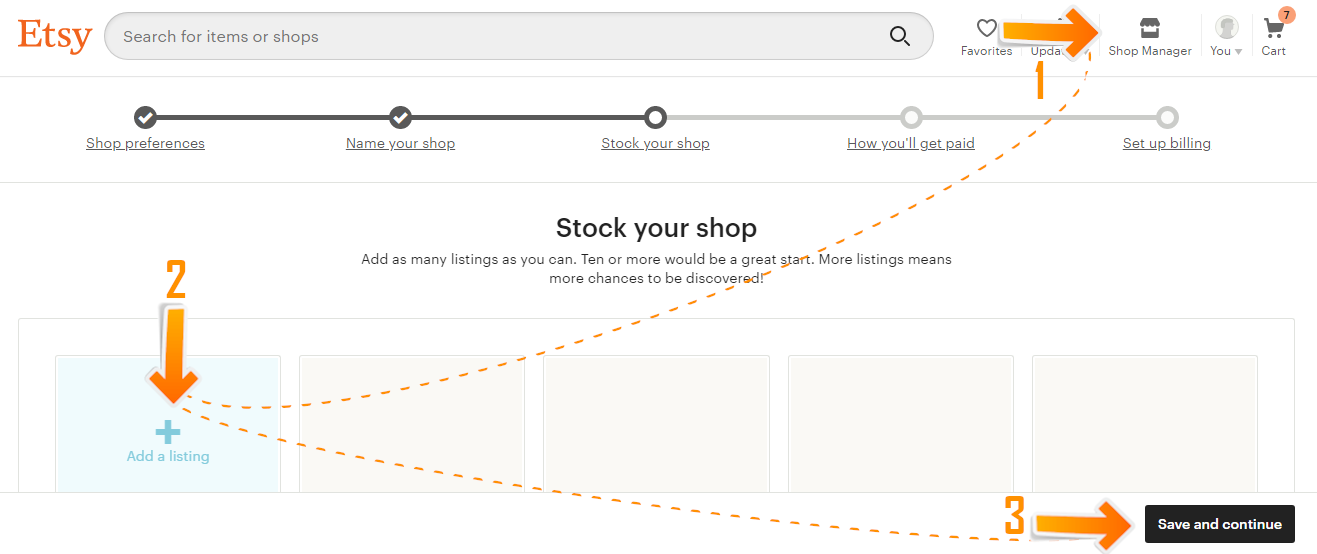
If you have more than one product photo, you must choose a thumbnail photo, which will be the photo that appears when customers search for your product.
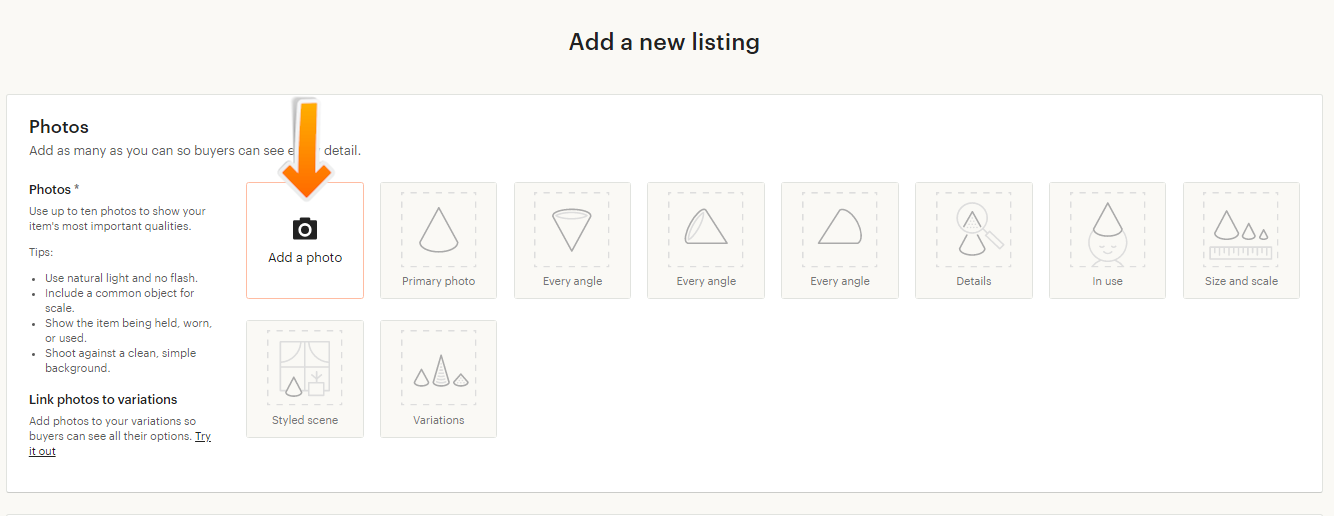
Price your product. Research Etsy and Google to see what other sellers are asking for products similar to yours, and then gauge yours accordingly. You may want to offer special pricing or introductory sale pricing to get your shop more traffic at first.
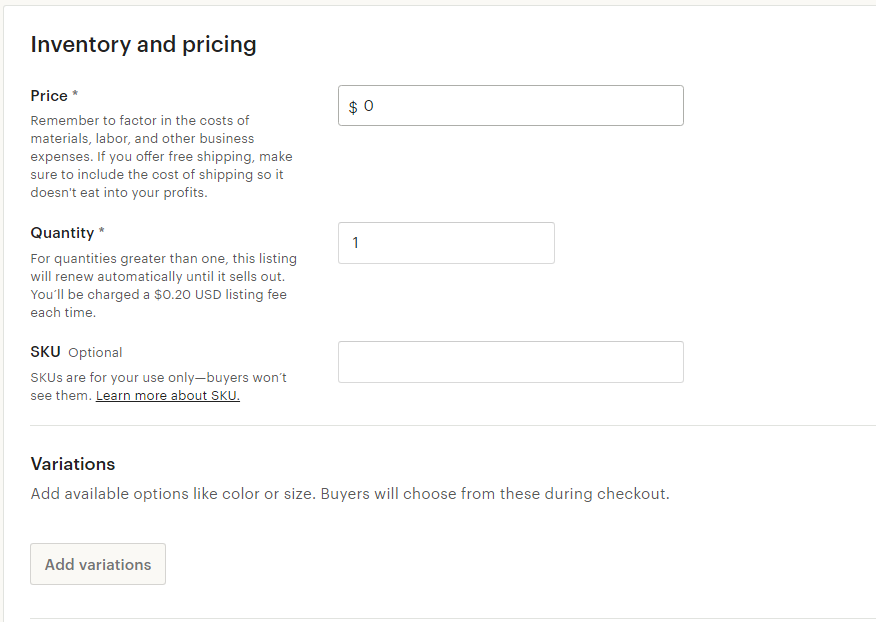
Name, categorize, and describe your product. First, give your listing a title — the name of your product. Then, choose the appropriate category — just begin typing your category (“women’s shoes” or “custom jewelry”) and the box will suggest relevant categories.
Then, describe your product. This is another opportunity for your personality to show and to describe any details for the products that buyers might find helpful. For instance, if you’re selling plants, are the plants rooted, or are they cuttings? This transparency increases the likelihood customers will trust your shop.
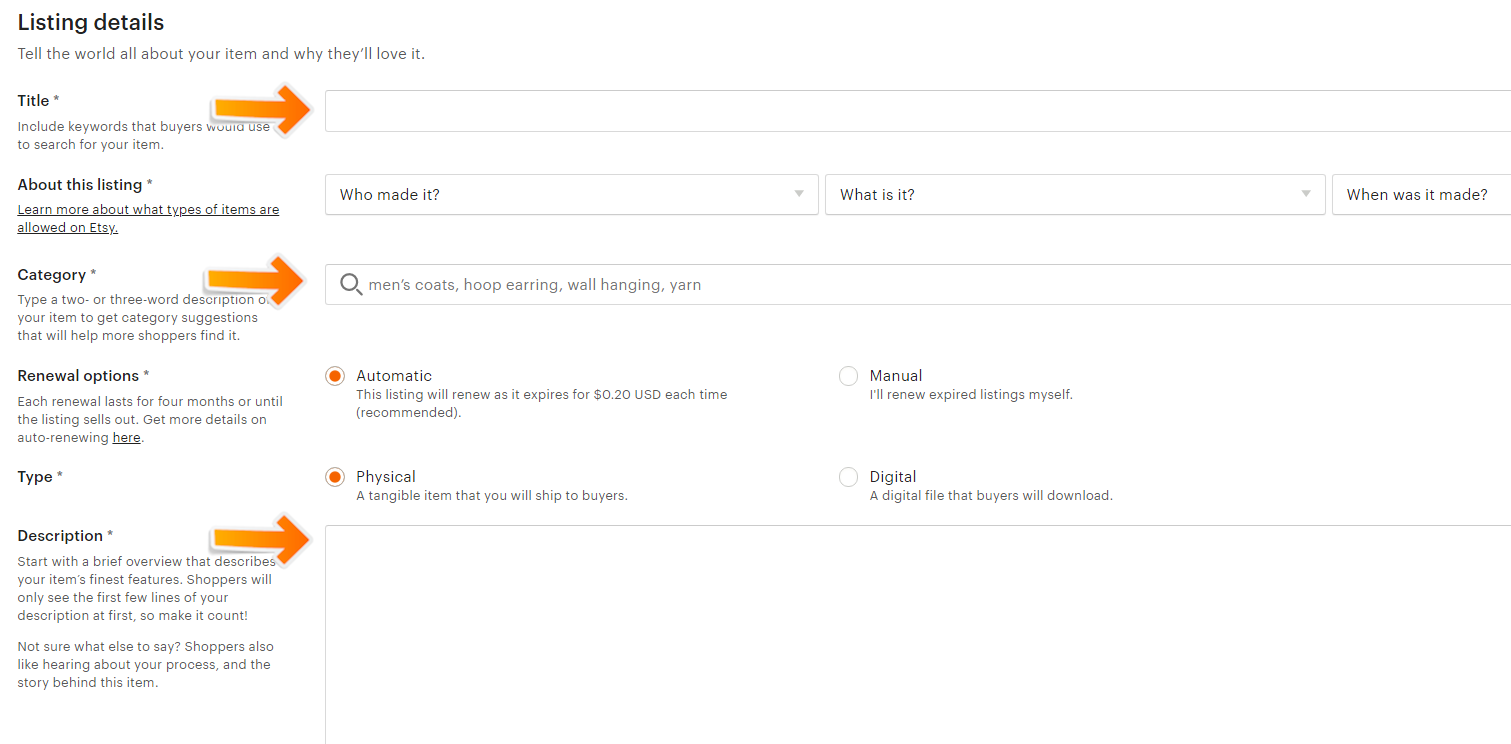
Set up shipping. This is available in the “Settings” section under “Shop Manager” and then “Shipping.” There are lots of options based on size and weight and international versus domestic. If you have questions about which type of shipping would work best for your shop, it’s a great time to consult forums and ask fellow Etsy sellers.
Finally, don’t be afraid to ask for help. There are lots of tools available to help your listings go further or to help you handle the more complex aspects of listing, such as Etsy’s taxonomic structure. Services like Sellbrite offer multiple listing platforms (googleshop +etsy) or listings integrated with other apps specific to your business.
Day 8: Download the Etsy Mobile App
The Etsy mobile app isn’t just for buyers — you can manage your entire store from a phone or tablet.
Go to the App Store or Google Play on your device, and download the Etsy mobile app for free.
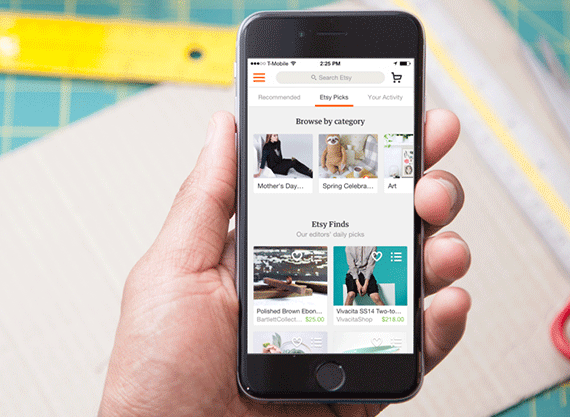
Sign in to your seller account; from there, you can manage listings, reviews, and orders, as well as increase your social media presence for your shop.
The mobile app allows for notifications so that you can respond to buyers or questions instantly, ensuring that you have solid customer service at your shop. Fast response time to customer questions will also boost your good standing.
Day 9: Launch Your Shop
Day nine is the time for you to officially launch your Etsy shop — to send your new child into kindergarten and hope they make friends.
If your profile and listings are ready to go, and you’re happy with how everything looks, it’s time to open your shop. To make your shop “live,” simply sign in to your seller account and click “Open Your Shop.” A successful launch is not only based on having all of your ducks in a row but also usually includes some social media and marketing. Be sure that those campaigns are in place to create a buzz and help customers find your shop.
Opening your shop means you are live and ready to sell your wares. Customers can contact or buy once the shop is open, so make sure you are opening at a time when you’re ready to take on the commitment of regular customers.
Day 10: Market Your Etsy Shop Everywhere
The 10th day is where the real selling starts — selling your brand, selling your products, and, most importantly, selling yourself. Now it’s time to channel your inner Don Draper and get to marketing.
There are many easy, effective ways to promote your shop on social media.
Share your best products on social media. If you’re looking to employ social media marketing yourself, you’ll want to choose some of your most impressive products as well as a create a brief description of your shop to share on social media. Most of the keywords you chose for your SEO campaign can be used as a hashtag on Instagram.
Consider buying ads. Social media marketing can consist of buying ads and setting up a campaign with social media providers or services. Facebook ads and Twitter ads are extremely easy to set up, and you can set any level of budget (per day or per click) you want to make sure you don’t get surprised with a huge bill.
Join the community. There are also lots of communities on social media for small-business owners. Find one based on your area, product, or socioeconomic background to link up with other businesses. Look for hashtags related to your product or industry, and peruse them for frequent posters.
Use video on social media. And of course, don’t neglect the power of video on social media. Consider creating videos for your most striking products — even five-second clips with some dynamic editing and fun music.
Launching Your Shop Isn’t the End
In just 10 days, you can learn all of the basics of selling on Etsy, creating your brand, and launching both your store and your marketing campaign.
What happens next is up to you (and a little bit of fate). You never know until you try. Your Etsy shop could be the seed of an ecommerce empire. Good luck in the days ahead.
The rest of your journey is up to you.
Digital & Social Articles on Business 2 Community
(46)

